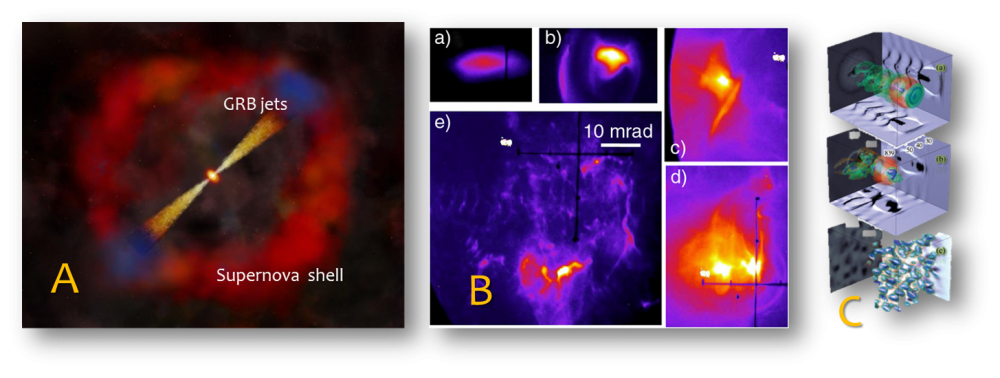The electron acceleration capability of the Hercules laser allows researchers to investigate phenomena not previously studied in the laboratory, including effects relevant to some of the most energetic events of in the universe, gamma ray bursts (GRBs). These intense flashes of high-energy photons exist for only short periods, from fractions of a second to minutes, followed by an “afterglow” of emission at longer wavelengths. Although the details of GRB origins are unclear, there is growing evidence linking them to supernovae, the violent explosions that occur when stars have consumed enough of their nuclear fuel to cease being supported by thermal energy. Recent theories suggest that the radiation signature of GRBs may be the result of the interaction of ultra-relativistic electrons ejected from a supernova with small-scale magnetic fields. These tiny, “tangled” magnetic fields are thought to be created by the two-stream filamentation instability, also known as the Weibel Instability, of the beaming electrons. As a beam of electrons passes through a plasma, small perturbations in the electron-beam density form current “hot spots,” which induce magnetic fields and eventually lead to localized magnetic structures. Understanding the signatures of GRBs is an area of active research, and experiments at Hercules are investigating some of the proposed underlying mechanisms.
 Fig. (A) Illustration of Gamma-Ray Burst [NASA/CXC/M.Weiss]; (B) Representative electron beam profile images in the transverse (x2 x3, horizontal-vertical) plane for nozzle lengths (1) 0.5 mm, (2) 1 mm, (3) 2 mm, (4) 3 mm, (5) 5 mm; (C) PIC simulation of electron beam propagation in plasma after 0.84 mm and 2.9 mm and filamentation (5 mm) [Huntington et al. , PRL 2011].
Fig. (A) Illustration of Gamma-Ray Burst [NASA/CXC/M.Weiss]; (B) Representative electron beam profile images in the transverse (x2 x3, horizontal-vertical) plane for nozzle lengths (1) 0.5 mm, (2) 1 mm, (3) 2 mm, (4) 3 mm, (5) 5 mm; (C) PIC simulation of electron beam propagation in plasma after 0.84 mm and 2.9 mm and filamentation (5 mm) [Huntington et al. , PRL 2011].
